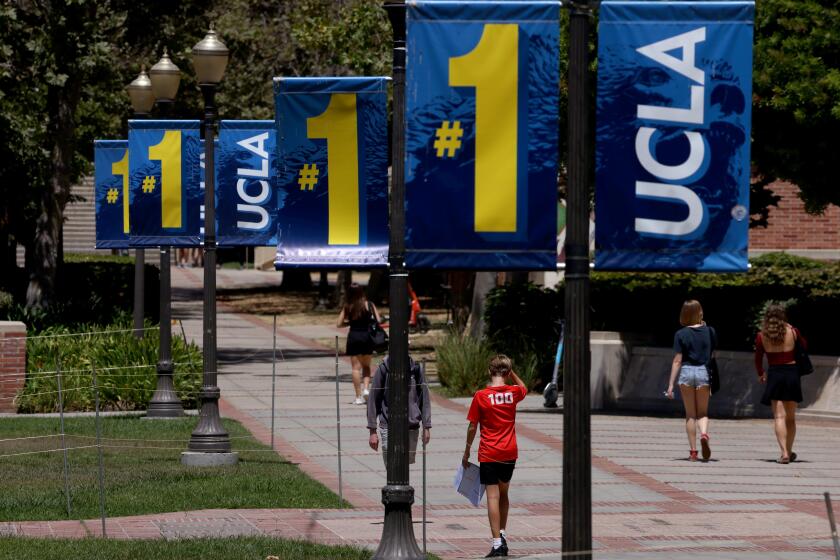Schools Challenge Estimate of Disney Project’s Impact : Environment: Both Anaheim districts say proposed expansion would bring more students, greater costs than report says. They ask more time to comment on plan.
- Share via
ANAHEIM — An attorney for Anaheim’s two school districts said Tuesday that the $3-billion Disneyland expansion project would bring more students to the schools and cost the districts more money than estimated by the draft environment impact report on the project.
Attorney John E. Brown, who represents both the Anaheim City School District and the Anaheim Union High School District, said that assumptions made in the report, including the needs for portable classrooms and switching to year-round schools, are “philosophically opposite” to the views traditionally held by district officials. The district has asked the city to extend the comment period on the draft EIR beyond the Dec. 28 deadline.
To help assess the draft EIR, the districts hired the Oakland-based firm of Recht Hausrath & Associates to analyze the impacts of the proposed Disney expansion. The consultants came to vastly different conclusions than the draft EIR paid for by Disney, Brown said.
For example, the elementary school district estimates that the project would result in about 372 new students and cost it more than $7.9 million. The EIR, however, says there will be only about 170 new students at a cost of $1.8 million.
The high school district estimates that the project would bring another 513 students to its schools, adding $11.4 million in expenses. The EIR predicts 149 new students at a cost of $1.5 million.
As a result of the differences and the sheer volume of the city’s draft EIR, the school districts have asked city officials to extend the 45-day review process by a month.
In a letter to the city manager’s office, Brown said the 45-day minimum review period required by law is not enough time to analyze the draft EIR, “particularly in light of the various legal holidays which fall within the review period.”
The districts are not the only group asking that more time be given to the review process. Garden Grove city officials have asked several times that the review period be extended. Anaheim officials have denied Garden Grove’s request.
Disney officials could not be reached for comment.
Anaheim Deputy City Manager Tom Wood said he could not comment on the districts’ review of the EIR because he had not seen a copy of their complete findings.
“We are sticking to our schedule of 45 days,” he said.
Brown, in an interview from his Riverside office, said the city and the districts need more time to address some of their “fundamental differences” and assumptions about the project’s impacts.
The districts’ estimates of the financial impact of the project are higher than those in the draft EIR because the districts assume that new facilities would have to be built and new land might need to be acquired.
The districts and draft EIR written for the city are also at odds in estimating the number of people who would relocate to the city as a result of the project.
Brown said the draft EIR, in making its cost analysis, assumes that the districts would go to year-round schools and put new students in portable or mixed-use facilities on existing school grounds.
Currently, only nine of the 21 elementary schools and none of the high schools operate year-round.
Brown said the districts do not want portable facilities if they can be avoided, and want “the flexibility of not going year-round.” The draft EIR’s assumptions, he added, would also reduce school playground space.
Brown also said that the draft EIR does not fully take into account the Disney project’s impact on available housing. He said a project of such size “historically results in multiple occupancy of single-family homes.”
“One of the things we hope to do with the (review) extension is get a handle on the assumptions,” Brown said. “It’s a very imperfect science.”
There is less than a month left in the EIR review process, which began when the city and Disney made public the draft EIR on Nov. 13. The final report, which is mandated by law, must take into account public comment and criticism, and answer questions raised about the project. The final EIR must be approved by the City Council before construction on the project can begin.
Though the entertainment company has invested millions of dollars in planning the expansion and drafting the EIR, Disney officials say they have not yet committed to the project. They say a decision to build the project won’t be made until the final EIR is approved and the economic feasibility of the project is confirmed.
Current plans for the expansion called for three hotels, a futuristic theme park called Westcot Center, a 5,000-seat amphitheater, garden and retail districts, a six-acre lake and two of the nation’s largest parking structures.
More to Read
Sign up for Essential California
The most important California stories and recommendations in your inbox every morning.
You may occasionally receive promotional content from the Los Angeles Times.













